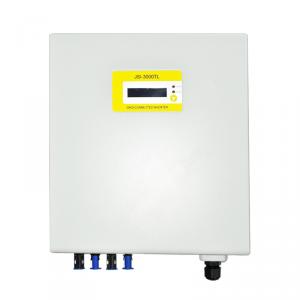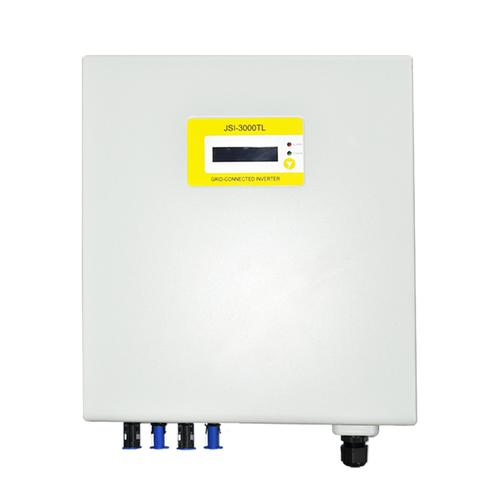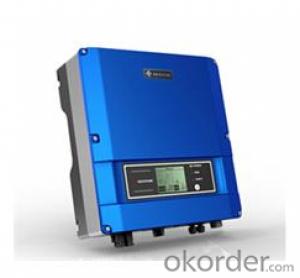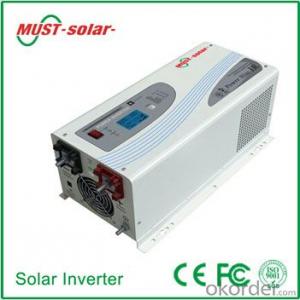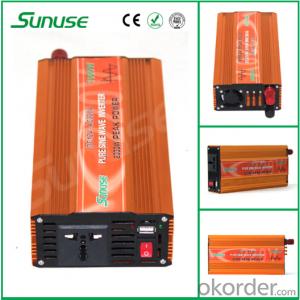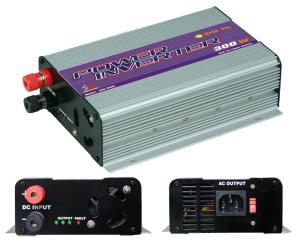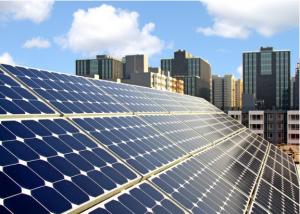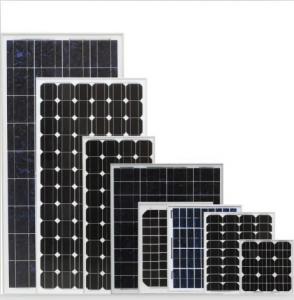Canadian Solar Grid Connected Solar Inverter 3000W
OKorder Service Pledge
Quality Product, Order Online Tracking, Timely Delivery
OKorder Financial Service
Credit Rating, Credit Services, Credit Purchasing
You Might Also Like
Grid connected solar inverter 3000W
◆ Compact size and high power density
◆ High speed MPPT for real time power tracking and improved energy harvesting
◆ Transformerless operation for highest efficiency 97%
◆ High overload capability under most ambient conditions
◆ Certified grid connected operation according to the international standards
◆ True sine wave output
◆ Integrated RS485/RS232 serial communications
◆ Multi-language LCD display
| MODEL | 1100TL | 1500TL | 2000TL | 2500TL | 3000TL | 3600TL | 5000TL | 6000TL |
| Max. DC Input Power(W) | 1200 | 1750 | 2300 | 2700 | 3660 | 3750 | 5300 | 6400 |
| Max DC Voltage(Vdc) | 450 | 450 | 500 | 550 | ||||
| MPPT Operating Range(Vdc) | 60~450 | 100~450 | 100~500 | |||||
| Number of Parallel Inputs | 1 | 2 | 3 | |||||
| Number of MPPT Trackers | 1 | |||||||
| Max. Input Current(A) | 11.7 | 10 | 13 | 14.5 | 20 | 20 | 22.5 | 27.5 |
| Nominal Output Power(W) | 1100 | 1500 | 2000 | 2490 | 3000 | 3600 | 4600 | 6000 |
| Max. Output Power(W) | 1100 | 1650 | 2200 | 2490 | 3400 | 3600 | 5000 | 6000 |
| Nominal Output Current(A) | 4.8 | 6.5 | 8.7 | 10.8 | 13 | 15.7 | 20 | 26 |
| Max. Output Current(A) | 5.7 | 7.9 | 10.5 | 12 | 15.7 | 16 | 24 | 29.3 |
| Nominal AC Output Voltage(Vac) | 230 | |||||||
| AC Output voltage range (Vac)* | 190~265 | |||||||
| AC Grid frequency range (Hz)* | 50±5 | |||||||
| Power Factor (cosφ) | >0.99 | |||||||
| THDI | <3%(at nominal output power) | |||||||
| Max.efficiency | 96.50% | 96.50% | 97.00% | 97.10% | 97.20% | 97.30% | 97.40% | 97.40% |
| Euro.efficiency | 95.40% | 95.50% | 96.20% | 96.30% | 96.40% | 96.60% | 96.80% | 96.80% |
| MPPT. efficiency | 99.60% | 99.60% | 99.60% | 99.60% | 99.60% | 99.60% | 99.60% | 99.60% |
| Operating Temperature(℃) | -25~+60 | |||||||
| Noise typical[dB(A)] | ≤20dB(A) | |||||||
| Operating Consumption(W) | 0 | |||||||
| Electrical Isolation | Transformerless | |||||||
| Cooling Concept | Natural cooling | |||||||
| Protect Level | IP65 | |||||||
| Communication | RS232(WiFi optional) | |||||||
| Dimension (W×D×H)(mm) | 345*152*315 | 345*152*355 | 345*152*385 | 345*152*505 | 345*162*573 | |||
| Weight (Kg) | 12 | 13 | 15 | 19 | 24 | |||
| *AC grid voltage range and frequency range depend on local standards | ||||||||
- Q: How do you calculate the efficiency of a solar inverter?
- To calculate the efficiency of a solar inverter, you need to divide the output power by the input power and multiply the result by 100 to get a percentage. The formula is: Efficiency = (Output Power / Input Power) * 100.
- Q: What is the role of a surge protector in a solar inverter?
- The role of a surge protector in a solar inverter is to protect the inverter and other connected devices from power surges or voltage spikes that can occur in the electrical system. It helps to regulate and stabilize the incoming electricity, preventing damage to the inverter and ensuring the smooth and efficient operation of the solar power system.
- Q: Can a solar inverter be used with batteries?
- Yes, a solar inverter can be used with batteries. In fact, many solar energy systems use a solar inverter to convert the DC (direct current) power generated by solar panels into AC (alternating current) power that can be used by household appliances. By integrating batteries into the system, excess solar energy can be stored for later use during periods of low sunlight or at night, providing a reliable and continuous power supply.
- Q: How does a solar inverter handle voltage unbalance in the grid?
- A solar inverter handles voltage unbalance in the grid by continuously monitoring the grid voltage levels. If it detects voltage unbalance, it adjusts the output power accordingly to maintain a balanced operation. This is achieved through internal control algorithms that ensure each phase of the grid receives the appropriate amount of power, correcting any imbalances and preventing potential damages to the solar inverter or the grid.
- Q: Can a solar inverter be used with different types of monitoring systems?
- Yes, a solar inverter can be used with different types of monitoring systems. Solar inverters are designed to convert the direct current (DC) electricity produced by solar panels into alternating current (AC) electricity that can be used in homes or businesses. While some inverters come with built-in monitoring systems, they can also be connected to external monitoring systems that provide more advanced data and analytics. This allows users to monitor and manage their solar power generation and consumption effectively, regardless of the monitoring system they choose to use.
- Q: What is the role of a solar inverter in a solar power system?
- The role of a solar inverter in a solar power system is to convert the direct current (DC) electricity produced by the solar panels into alternating current (AC) electricity that can be used to power household appliances and be fed back into the electrical grid. The inverter also ensures that the power generated by the solar panels is at the correct voltage and frequency for safe and efficient use.
- Q: Can a solar inverter be used with a solar-powered agricultural irrigation system?
- Yes, a solar inverter can be used with a solar-powered agricultural irrigation system. The solar inverter is responsible for converting the direct current (DC) produced by the solar panels into alternating current (AC) that can be used to power the irrigation system. This allows for efficient utilization of solar energy to operate the irrigation system, reducing reliance on traditional power sources and promoting sustainable agriculture practices.
- Q: What are the key factors affecting the installation process of a solar inverter?
- The key factors affecting the installation process of a solar inverter include the location and orientation of the solar panels, the size and capacity of the inverter, the electrical infrastructure of the building, the type of mounting system used, and compliance with local regulations and building codes. Additionally, factors such as shading, temperature, and maintenance accessibility should also be considered during the installation process.
- Q: What are the key factors affecting the cost of a solar inverter?
- The key factors affecting the cost of a solar inverter include the capacity or size of the inverter, the efficiency of the technology used, the brand and quality of the product, the level of advanced features and functionalities, and the overall demand and supply in the market. Additionally, factors such as installation and maintenance costs, warranty and after-sales support, and government incentives or subsidies can also impact the overall cost of a solar inverter.
- Q: What is the role of a solar inverter in a solar-powered electric fence?
- The role of a solar inverter in a solar-powered electric fence is to convert the direct current (DC) electricity produced by the solar panels into alternating current (AC) electricity, which is required to power the electric fence. The solar inverter also regulates and stabilizes the voltage and frequency of the electricity to ensure proper functioning of the electric fence system.
Send your message to us
Canadian Solar Grid Connected Solar Inverter 3000W
OKorder Service Pledge
Quality Product, Order Online Tracking, Timely Delivery
OKorder Financial Service
Credit Rating, Credit Services, Credit Purchasing
Similar products
Hot products
Hot Searches
Related keywords
